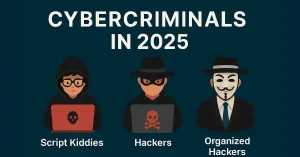A computer virus is a program, script, or macro created to harm a computer, steal private information, change data, send e-mail, and display messages. More importantly, when the viruses were executed, they spread by
copying itself into or over the following:-
- Data files
- Programs
- The boot sector of a computer’s
- Hard drive
- Potentially anything else writable.
Virus writers use detailed knowledge of security vulnerabilities to gain access to a host’s computer.
When was the term “Virus” First Used
The theory of a computer program capable of reproducing itself was first mentioned by John von Neumann in his 1949 “Theory of self-reproducing automata” essay.
First computer virus ever created.
How to protect your computer from viruses
Anti-virus software is the solution to protect a computer from viruses. Once installed on a computer an antivirus monitors, detects, and cleans any computer viruses.
Examples of computer viruses
There are many types of computer viruses, such as:-
- Appending virus
- Boot sector virus
- Space filler virus
- Cavity virus
- CMOS virus
- Companion virus
- Encrypted virus
- Exe Virus
- Rabbit Virus
- MBR virus
- Non-resident virus
- Overwrite and Stealth virus
The history of computer viruses is too long and it is very difficult to cover it in a single article. in the following, I am giving a list and a short introduction of the 10 most destructive viruses in the world ever.
20 A most destructive virus in the world
1. CIH
CIH virus was created in 1998 in Taiwan. The virus destructs and corrupts computer data after when activated. The virus infects all executable files in Windows 95 and 98 systems. Once the virus-activated, it destroys the computer’s hard disk data and overwrites the system’s BIOS chip which also requires BIOS chip reprogramming otherwise system cannot boot at all.
2. Melissa
This computer virus was created by David L in 1999 and was named after a Florida dancer. It started as an infected Word document that was posted on the alt-six USENET group, claiming to be a list of passwords for pornographic sites. This got people curious, and when it downloaded and opened, it would trigger the macro inside and unleash its payload. The virus will mail itself to the top 50 people in the user’s email address book, and this causes an increase in email traffic and disrupts the email services of governments and corporations. It also sometimes corrupts documents by inserting a Simpsons reference into them.
3. ILOVEYOU
Another very deadly computer virus was the “I love you” virus. Everybody loves to hear these words, right? This virus was developed in 2000 to attack the basis of the loveliest human emotion. A user gets an email with the subject line “I Love You”. And to express more love, there is an attachment that states “Love letter for you”. If you happen to click the attachment, which everybody else would for sure, the virus will activate itself. And the same email would be sent to the top 50 people in the Windows address book. Rightly said by someone, love is surely dangerous.
4. Beast Trojan Horse
Beast Trojan Horse was developed in 2002. The virus infects a user’s computer system completely after activating. Until the user clicks and executes the virus, it remains safe and does not harm. But, after the execution, it replicates itself and several copies will be stored in multiple directories of your computer system. Having the reverse connection capability, a remote user can access your file manager, registry editor, Webcam, power options files, remote IP scanner, including many other options.
5. Sobig.F
Sobig. F was created in 2003. This virus attacked Internet gateways and email servers, causing big damage in billions of dollars. It slows down all the global Internet access. It is used to collect different email addresses from the infected computer systems. Then the virus would send its multiple copies to all these addresses.
6. SQL Slammer
SQL Slammer was founded in 2003. it crashes servers and slows down all Internet traffic. Now, the SQL base has nothing to do with it. SQL Slammer infected the servers on UDP and packed them in a single packet. As a result, routers could not work. It is a fast-spreading antivirus and infects most of its 75,000 victims within ten minutes. SQL Slammer significantly slowed down general Internet traffic. It generally targeted the servers generating random IP addresses and discharging the worm to those IP addresses.
7. My Doom
Mydoom was a worm for Windows that appeared in 2004 and created a huge wave of shocking email messages. This is the fastest-spreading email worm since ILOVEYOU. The virus would come as an email attachment to your email inbox. You would receive a misleading message like “mail transaction failed”. When a user clicks on the mail, the virus gets activated. The worm would get transferred to the address book of the mail.
The author of this virus is unknown, and I think the creator was paid to create it since it has the text message, “Andy; I’m just doing my job, nothing personal, sorry,”. It was named by McAfee employee Craig Schmugar, one of the people who had discovered it. ‘Mydom’ was a line of text in the program’s code (my domain), and sensing this was going to be big, I added ‘doom’ into it.
8. Code Red
Code Red was discovered by two eEye Digital Security employees in 2001. The pairs were drinking Code Red Mountain Dew at the time of discovery, so its name became Code Red. The worm targeted the Microsoft IIS web server installed computer and exploited a buffer overflow problem in the system. It leaves very little trace on the hard disk as it can run entirely on memory, with a size of 3,569 bytes. Once infected, it will make a hundred copies of itself, but due to a bug in the programming, it will duplicate even more and end up eating a lot of the resources of the system.
9. Sasser
This was a dangerous virus created by a 17-year-old German boy, Sven Jaschan a comp in 2004, and the virus proved to be very destructive. It hit several big names like the British Coast Guard, Delta Air Lines, and Agence France-Presse. It slows down and crashes the computer while making it hard to reset without cutting the power; the effects were incredibly disruptive; with millions of computers being infected, and important, critical infrastructure affected.
The worm took advantage of a buffer overflow Vulnerability in Local Security Authority Subsystem Service (LSASS); which controls the security policy of local accounts causing crashes to the computer. It will also use the system resources to propagate itself to other machines through the Internet and infect others automatically.
10. Bandook Rat
Bandook Rat is similar to Beast Trojan Horse, is more destructive than the latter. Developed in 2005. It is a backdoor Trojan horse entering Windows operating systems, mainly, such as Windows NT, XP, 2000, 2003, Vista, and 7. It is still being worked upon to make it one of the most dangerous computer viruses of all time.
11. Leap-A
Leap-A is also known as Oompa-A, created in 2006. It targeted Mac systems and used the iChat instant messaging app to propagate across vulnerable Mac Computers. After infecting the Mac computer, the virus spreads itself to all iChat contacts and sends a message to every person.
12. Storm Worm
This virus was created in the year 2006, and it hit the mail inboxes. It is a backdoor Trojan horse. People get an email with the subject line “230 dead as storm batters Europe”. The Storm Worm virus easily tricks the victims into clicking on the fake links that are already infected by the virus, turning any Windows computer into a botnet. As of January 22, 2007, the Storm Worm accounted for 8% of all malware infections globally. The Storm Worm also allows a remote user to operate the system to send spam over the Internet.
13. Anna Kournikova virus
Anna Sergeyevna Kournikova is a Russian former tennis player. Her look and personality status made her one of the best-known tennis stars worldwide. At the peak of her fame, fans looking for images of Kournikova made her name one of the most common search strings on Google Search.
So, her name brings a lovely picture of a beautiful tennis-playing woman. And the younger guys easily cheated on the name of that beautiful tennis star. This virus comes to the mail inbox in the form of an email message. When someone opens the mail, the virus gets forwarded to all the contacts present in the mail address book.
14. Conficker virus
Conficker, also known as Downup or Downadup, is a worm of unknown authorship for Windows. It first appeared in 2008 and its name comes from the English word, configure, and a German pejorative. It infects computers using flaws in the OS to create a botnet. It’s malware and was able to infect more than 9 million computers all around the world, affecting governments, businesses, and people. Conficker gave birth to a huge army of remotely controlled computer systems, which were used to steal important financial data and other information. Many experts and anti-virus researchers called it a “superbug” and “super worm” for its risky infection.
15. Nimda
The virus propagated in the year 2001. The virus name Nimda is the reverse of the word “Admin”. Nimda spread itself via emails, server weak points, shared folders, and file transfers. The virus saw its rise after the famous 9/11 attack, and people thought it to be a cyber-terror attack due to that.
16. Zeus
It’s a Trojan horse made to infect Windows computers so that it will do various criminal tasks. The most common of these tasks are usually man-in-the-browser keylogging and form grabbing. Zeus was first identified in 2009.
17. Stuxnet
Israeli Defence Force and the American Government created Stuxnet is an example of a virus created for cyber warfare, as it was intended to disrupt the nuclear efforts of the Iranians. It was estimated that Stuxnet had managed to ruin one-fifth of Iran’s nuclear centrifuges and that nearly 60% of infections were concentrated in Iran.
18. Mydoom
Mydoom was a worm for Windows that appeared in 2004 and became one of the fastest-spreading email worms since ILOVEYOU. The author is unknown, and I think the creator was paid to create it since it has the text message, “Andy; I’m just doing my job, nothing personal, sorry,”. It was named by McAfee employee Craig Schmugar, one of the people who had discovered it.
“Mydom” was a line of text in the program’s code (my domain) and sensing this was going to be big, added ‘doom’ into it. The worm spreads itself by appearing as an email transmission error and contains an attachment of itself. Once executed, it will send itself to email addresses that are in a user’s address book and copy itself to any P2P program’s folder to propagate itself through that network.
19. CryptoLocker
CryptoLocker is a form of Trojan horse targeted at computers running Windows. It uses several methods to spread itself, such as email, and once a computer is infected, it will encrypt certain files on the hard drive and any mounted storage connected to it with RSA public key cryptography. While it is easy enough to remove the malware from the computer, the files will remain encrypted.
20. Flashback
The Trojan was first discovered in 2011 by antivirus company Intego as a fake Flash install. In its newer incarnation, a user simply needs to have Java enabled (which is likely the majority of us). It propagates itself by using compromised websites containing JavaScript code that will download the payload. Once installed, the Mac becomes part of a botnet of other infected Macs.
21. Blaster (MSBlast):
- Blaster, also known as MSBlast, was a computer worm that appeared in 2003. It targeted Windows XP and Windows 2000 systems, exploiting a vulnerability in Microsoft’s Remote Procedure Call (RPC) service. Blaster caused infected computers to display a message box with text mocking Microsoft.
22. Conficker (also known as Downup, Downadup):
- Conficker is a worm that emerged in 2008 and quickly became one of the most significant malware threats. It exploited vulnerabilities in Windows to create a massive botnet of infected computers, which could be used for various malicious purposes.
23. Slammer (SQL Slammer):
- SQL Slammer, also known as SQL Hell, is a worm that struck in 2003. It exploited a vulnerability in Microsoft SQL Server and Desktop Engine, leading to a rapid spread that significantly disrupted the Internet by overloading servers.
24. Blaster (Blaster Worm):
- Blaster Worm, also known as MSBlast or Lovesan, emerged in 2003. It exploited a Windows vulnerability to spread rapidly and targeted a specific service known as RPC DCOM. Once infected, the worm caused computers to reboot continually.
25. Storm Worm (Storm Botnet):
- Storm Worm, which appeared in 2007, is a Trojan horse that was widely distributed through malicious email attachments. It was used to create a botnet for sending spam and other malicious activities.
26. Ikee (iPhone Worm):
- In 2009, a worm known as Ikee specifically targeted jailbroken iPhones. The worm altered the iPhone’s wallpaper and asked for a ransom in exchange for fixing the device.
27. Blaster Worm (Welchia):
- Welchia, also known as MSBlast.D, was a variant of the original Blaster Worm and emerged in 2003. It was designed to remove the original Blaster Worm and then download security patches from Microsoft to fix the vulnerability.
28. Storm Worm (Zhelatin):
- Storm Worm, also known as Zhelatin, spread through email attachments with enticing subject lines. It was one of the first examples of social engineering tactics to encourage users to open malicious attachments.
29. Slapper (Apache Worm):
- Slapper, or Apache Worm, targeted Linux servers in 2002. It exploited a vulnerability in the OpenSSL library, and once infected, the worm could be used to launch distributed denial-of-service (DDoS) attacks.
30. Klez (Klez Worm):
- The Klez worm, first discovered in 2001, spread via email attachments and could also spoof email addresses. It was responsible for considerable email traffic and infected many computers.
FAQs
What is a computer virus?
- A computer virus is a program, script, or macro designed to cause harm, steal private information, change data, send emails, and display messages. When executed, viruses spread by copying themselves into or over data files, programs, the boot sector of a computer’s hard drive, and potentially anything else writable. Virus writers use their detailed knowledge of security vulnerabilities to gain access to a host computer.
How do computer viruses spread?
Computer viruses spread by copying themselves into various files and locations, such as data files, programs, the boot sector of a computer’s hard drive, and other writable areas. They can also be transmitted through email attachments, infected websites, and shared files. Once executed, viruses replicate and spread to other computers or devices.
Who was the first person to use the term “Virus” in the context of computer programs?
The term “virus” in the context of computer programs was first mentioned by John von Neumann in his 1949 essay titled “Theory of self-reproducing automata.”
What was the first computer virus ever created, and who developed it?
The first computer virus ever created was Elk Cloner, written by Rich Skrenta in 1982 when he was a 15-year-old high school student. Elk Cloner spreads by monitoring the floppy drive and copying itself to any floppy diskette. When an infected diskette was inserted into a computer, it would infect the system and display a short poem on every 50th boot.
How can you protect your computer from viruses?
To protect your computer from viruses, you can use antivirus software. When installed on a computer, antivirus software monitors, detects, and cleans any computer viruses to prevent infections and damage.
What are some examples of different types of computer viruses?
There are various types of computer viruses, including:
-
- Appending virus
- Boot sector virus
- Space filler virus
- Cavity virus
- CMOS virus
- Companion virus
- Encrypted virus
- Exe Virus
- Rabbit Virus
- MBR virus
- Non-resident virus
- Overwrite and Stealth virus
-
What is the history of computer viruses, and can you provide information about the 10 most destructive viruses in the world?
- The history of computer viruses is extensive and includes many notable examples of destructive viruses. Below are details about the 10 most destructive viruses:
- 1. CIH: Created in 1998 in Taiwan, the CIH virus destroys and corrupts computer data after activation, overwriting the system’s BIOS chip.
- 2. Melissa: Created in 1999, it spread through infected Word documents, disrupting email services.
- 3. ILOVEYOU: Developed in 2000, it arrived as an email with a subject line “I Love You” and caused widespread email traffic disruption.
- 4. Beast Trojan Horse: Developed in 2002, it completely infected a user’s computer system, allowing remote access.
- 5. Sobig.F: Created in 2003, it attacked Internet gateways and email servers, causing significant damage.
- 6. SQL Slammer: Founded in 2003, it crashed servers and slowed down global Internet access.
- 7. My Doom: Appeared in 2004, it spread rapidly through misleading email attachments.
- 8. Code Red: Discovered in 2001, it targeted Microsoft IIS web servers, consuming system resources.
- 9. Sasser: Created in 2004, it affected critical infrastructure by exploiting a Windows vulnerability.
- 10. Bandook Rat: Developed in 2005, it is a backdoor Trojan horse, mainly targeting Windows operating systems.
- The answers to FAQs 8 through 20 continue to provide details about other destructive computer viruses mentioned in the article.





